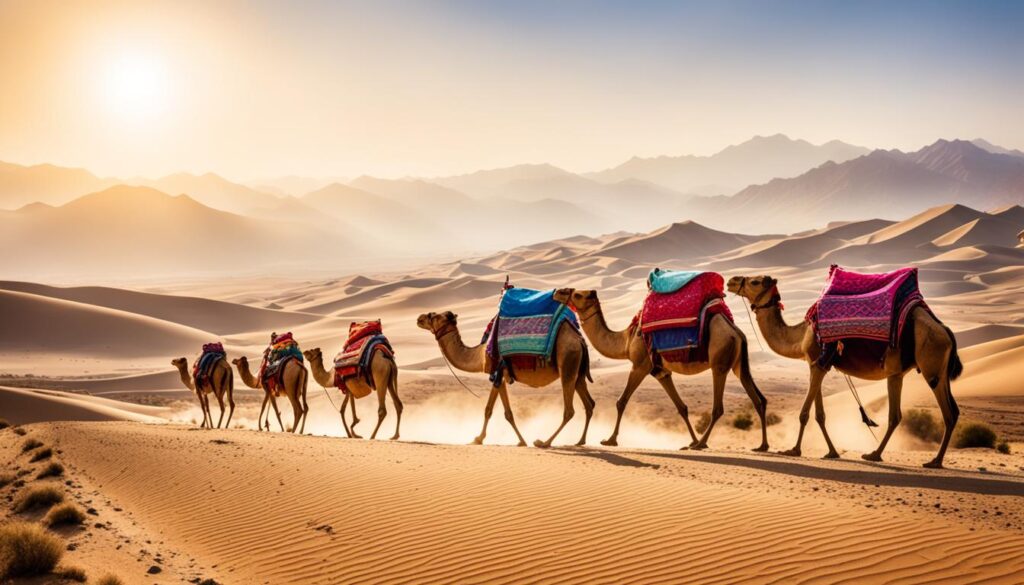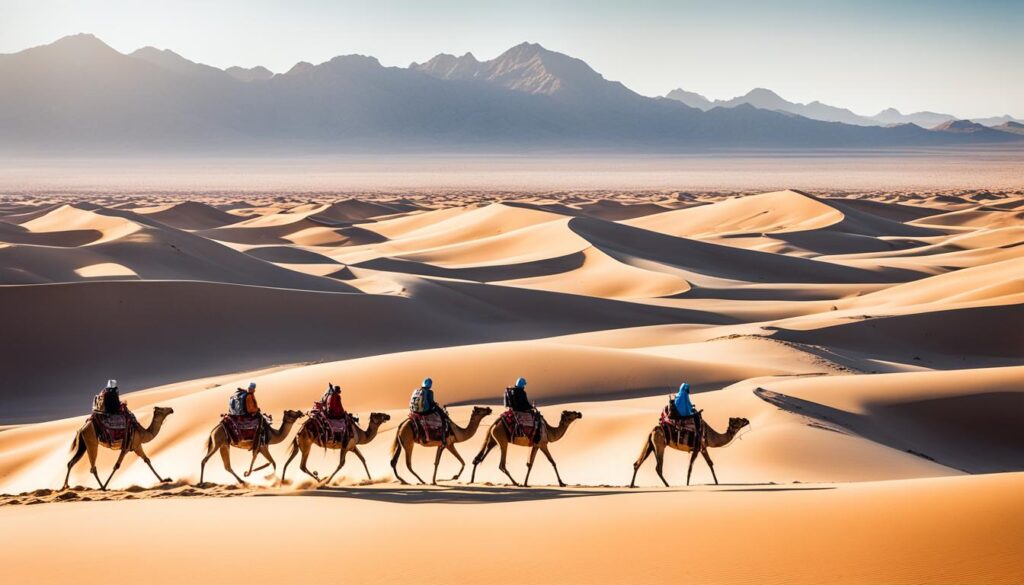Marco Polo, a brave Venetian explorer, set out on a journey through the Silk Road and the Mongol Empire. His stories of the wonders of Cathay (China) and the East’s grandeur have always fascinated people. They connected Europe and Asia’s civilizations.
Marco Polo’s voyages show us a key moment in history. It was when the East and West shared ideas, goods, and cultures more than ever. His detailed stories take us to a world of exotic lands, powerful leaders, and interesting historical facts.
This article will explore Marco Polo’s life and adventures. It will show how his travels changed exploration, trade, and the meeting of East and West.
Marco Polo: The Intrepid Explorer
Marco Polo was born in Venice, a city full of life by the sea. He was always drawn to the mysteries of the East. As a young man, he listened to stories of exploration and trade from the Silk Road. This network linked the Mediterranean to Asia’s distant lands.
From Venice to the Silk Road
At 17, Marco Polo embarked on a journey with his father Niccolò and uncle Maffeo. They headed back to Kublai Khan, the Mongol emperor. This trip changed Marco’s life, showing him the Silk Road and the Mongol Empire.
Early Life and Inspiration
In Venice, Marco Polo heard stories of medieval explorers. His father and uncle had traveled deep into Asia. Their stories of exotic lands and powerful leaders sparked Marco’s dream of adventure.
Marco Polo’s Silk Road journey and time with Kublai Khan shaped his life. His stories became famous, introducing Europeans to China and the East’s culture and wealth.
The Silk Road: Gateway to the East
The Silk Road was a network of ancient trade routes that linked the East and West during the medieval times. It was a key way for goods, ideas, and cultures to move between the two regions. This network changed history.
At the center of the Silk Road were places where merchants from all over came to trade. They brought things like silk, spices, gems, and handmade goods. These items helped grow the economy and started a big cultural exchange.

The Silk Road went through tough landscapes in Central Asia. It helped spread ideas, technologies, and beliefs between the East and West. Religions, philosophies, and art moved along the Silk Road, making the medieval world richer.
This network of trade routes made a lasting connection between East and West. It helped create a more connected global community.
The Silk Road was more than just a trade route. It was a place where ancient wisdom from China and India met with new ideas from the Islamic world and the Mediterranean. This mix led to a rich exchange of ideas and practices.
The Silk Road was like a preview of today’s global connections. It showed how sharing cultures can change the world. Its story still inspires people who love history and the connections that link us all.
Exploring the Mongol Empire
Marco Polo traveled deep into the Mongol Empire. He saw the grandeur and power of this vast civilization. He met Kublai Khan, the ruler, and learned about medieval diplomacy and cultural integration.
Encounters with Kublai Khan
Marco Polo reached Kublai Khan’s court on the Silk Road. Kublai Khan had united much of Asia. Polo learned about the Mongols’ military strength, their government, and their openness to new ideas.
Life at the Mongol Court
At the Mongol court, Marco Polo saw the rich life of the empire. He saw lavish ceremonies and the diversity of Kublai Khan’s rule. Polo’s stories give us a peek into the Mongols’ diplomacy and cultural exchange.
Marco Polo learned a lot about the Mongol Empire’s geography, economy, and society. His stories are now key for scholars to understand this medieval power.
Historical Curiosities: East Meets West
Marco Polo’s voyages were more than just about exploring new lands. They revealed many historical curiosities that amazed the West. He traveled the Silk Road and entered the Mongol Empire, finding cultural exchanges that changed how people saw the world.
Discoveries and Cultural Exchanges
Marco Polo made incredible discoveries on his travels. He saw the rich courts of Kublai Khan and the lively cities of Cathay. These places were far different from his own Europe. The sharing of ideas, tech, and goods showed how the medieval world was connected, a new idea for many Europeans.
One key discovery was paper money from the Mongol Empire. Polo was amazed by it and brought back stories of its benefits. This sparked interest in this new financial tool in the West.
Polo also shared stories of the Mongols’ advanced ways of life. He talked about their detailed government and rich culture. His stories of Cathay’s grand canals and beautiful palaces opened his friends’ eyes to the East’s beauty and complexity.

The exchange of knowledge between East and West during Marco Polo’s time started a new era of global connection. This era, thanks to the Silk Road and the Mongols, helped create a more united world. It led to better understanding and progress for all of humanity.
The Wonders of Cathay
Marco Polo set off on a grand journey from Venice to the East. He found a land that amazed the West with its wonders. Cathay, known as medieval Europe’s term for China, was full of riches and new technologies, as Polo’s stories showed.
Descriptions of China and Its Riches
Polo’s stories from his travels through the Mongol Empire and China showed the beauty and wealth of Chinese life. He was amazed by Kublai Khan’s city, Khanbaliq (now Beijing), with its big palaces, busy markets, and organized streets. He also talked about the rich cities like Hangzhou and Quinsai (also Hangzhou), where artists and traders did well.
Polo was also impressed by Chinese technology and new ideas. He talked about paper money, a big canal system, and big steps in building ships, engineering, and farming. His stories of Chinese skills in gunpowder, silk, porcelain, and luxury goods changed how Europeans saw Cathay.
Polo’s stories about Chinese culture and ways of life changed how the West saw this far-off place. He gave Europeans a peek into the imperial court, social order, and different religions of China. This had long been a mystery to them.
Navigating the Maritime Silk Road
Marco Polo’s journey took him through a vast network of trade routes between East and West. The Maritime Silk Road was a key part of his travels. It was a network of sea paths that helped trade goods, ideas, and cultures.
On the water, Polo saw the challenges of medieval sailing firsthand. He was amazed by the skill of traders. They used the monsoon winds to cross the Indian Ocean in ships.
Polo wrote about the different ships he saw on the Maritime Silk Road. He talked about big “treasure ships” from China and fast dhows from the Middle East. These ships carried things like spices, silks, gems, and exotic animals.
His stories showed how trade networks linked different places and people. They helped Europeans learn about the world beyond their borders. This knowledge led to more exploration and trade.
Legacy of the Travels
Marco Polo, a famous Venetian explorer from the 13th century, changed trade and exploration forever. His journeys along the Silk Road and through the Mongol Empire greatly influenced the medieval world. He opened doors for a new era of cultural and economic exchange between East and West.
Impact on Trade and Exploration
Marco Polo’s stories from Cathay (China) and other distant places gave European traders and explorers new insights. He described the East’s wealth and advanced civilizations in detail. This sparked a new interest in trade and exploration among others.
His legacy led to the growth of maritime trade routes. Explorers like Vasco da Gama and Christopher Columbus were inspired by Polo’s writings. Polo’s work played a big part in the Renaissance and the Age of Discovery. His stories changed European views of the “Far East,” showing its potential for trade and cultural exchange.
Marco Polo’s travels also boosted cultural exchange between Europe and Asia. His stories about Chinese technology, art, and customs changed European views. This sparked a new curiosity and respect for Asian cultures. It helped set the stage for deeper interactions between East and West over the years.
Separating Fact from Fiction
Marco Polo’s travels have been a topic of debate for a long time. His stories of the Mongol Empire, the city of Khanbaliq (now Beijing), and the wonders of Cathay (China) have amazed people for centuries. But, many have questioned the truth in his stories.
Scholars have tried to sort out what’s real and what’s not in Polo’s tales. They aim to find the truth behind the myths and legends linked to Polo.
Debunking Myths and Legends
Over the years, many myths and legends have grown around Marco Polo’s adventures. Some think his stories are just made-up, while others try to match his tales with historical facts. The challenges of understanding history from a medieval time add to the problem of knowing what’s true and what’s not.
But, new studies are helping us see things differently. Researchers are looking into original sources and archaeological discoveries to learn more about Polo’s travels. By carefully checking the evidence and comparing it with other historical records, we’re getting a clearer picture of what might be true in Polo’s stories.






